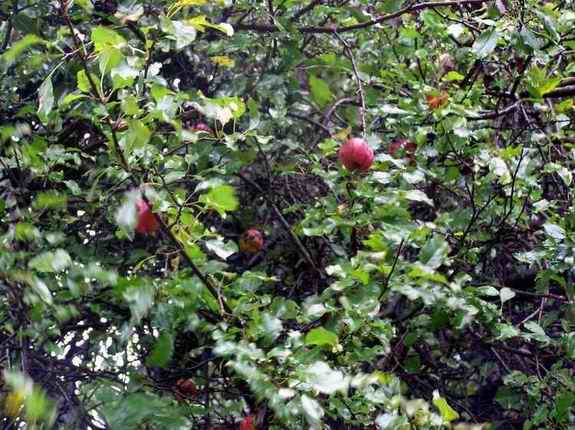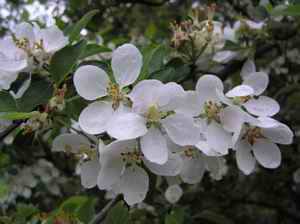|
Return to Hiker's Notebook Home Page
Common Name: Apple, Common Apple, Wild Apple, Pomme (French), Manzana (Spanish) - The etymology of apple is the Indo-European root ap, ab, af or av, differing according to the language (e.g. aballo in Celtic and afal in Welsh). The French pomme is from the Latin pomum, which means fruit. The apple was originally malum in Latin (from the Greek word for melon) but was changed to pomum in the 4th Century due to its importance in Christianity, thus establishing the apple as the "fruit of all fruits."
Scientific Name: Malus pumila - The generic name means both "bad" and "apple" in Latin, intimating that the fruit was perhaps sinful; it typically appears in myth as a temptation such as in the Garden of Eden. Malus may alternatively derive from the Greek word for melon or yellow; a yellow dye can be extracted from the bark of the apple tree. Pumila is from pumilus, the Latin word for dwarf. The apple is also known as Malus domestica, Malus sylvestris and Pyrus malus, depending on the text.
The common apple is not native to North America. However, as there are some hundreds of varieties, its origins are subject to some conjecture. Traditionally, it has been contended that it is an amalgam of several species, including M. sylvestris, M. pumila and M. sieverii. However, recent DNA analysis with twelve M. domestic cultivars revealed genetic sequences common only to the latter. M. sieverii is a native of central Asia in the Tien Shan Mountains near the capital city of Kazakhstan, Alma-Ata. The Russian botanist Nikolai Vavilov is credited with first identifying the origins of the apple in 1929, when he noted the extensive ranges of wild apple trees in this area. It is not altogether a matter of serendipity that Alma-Ata means "father of the apples." It is likely that the fruit was eaten by travelers along the Silk Road, encouraging the westward expansion of the species as they disbursed its seeds along the way.
The apple is heterozygous; it has a chromosomal arrangement that lends to hybridization of its offspring, a trait it shares with many species including humans. This genetic variability allows it to adapt more readily to new environments which has been key to its worldwide adaptation. However, the apple of a tree that started as a seed will almost always be virtually inedible, so sour as to "set a squirrel's teeth on edge and make a jay scream" according to Thoreau. For this reason, the common cultivar apple is grown from a grafted branch of an existing tree onto the root stock of another, thereby perpetuating identical genetic traits in the resultant fruit.
The first creditable account of apple grafting was in Greece in the 3rd Century BCE, where the apple was an important fruit, associated with love and marriage and figuring prominently in Greek Mythology. At the wedding of Hera to Zeus, the earth goddess Gaia produced the first apple tree as a present. The apple was also responsible for the Trojan War. At the wedding of the hero Peleus and sea-goddess Thetis, Eris, the goddess of strife, threw a golden apple inscribed "for the fairest" into the crowd. Hera, Athena and Aphrodite all laid claim to the title; wisely, Zeus chose the shepherd Paris to judge among the three. Hera offered him wealth and power, Athena glory and wisdom and Aphrodite the gift of love in the form of the most beautiful woman in the land. Paris gave the apple of discord to Aphrodite, who awarded him the hand of Helen, who was unfortunately married to a powerful Greek named Menelaus. The Trojan War to seek redress followed.
The apple made its way from Greece to Rome and via the Roman Empire to the rest of Europe. The naturalist and writer Pliny the Elder (Gaius Plinius Secundus) recorded that twenty three different types of apples were cultivated in Rome in his encyclopedic work Historia naturalis. The Romans brought the apple to England and early colonists brought seeds and grafted trees to North America. Records indicate that apples were being cultivated in Massachusetts by 1630, though there is evidence that they may have been planted on the offshore islands by fishermen a century earlier. The imported trees did not fare well in the harsh New England winters, the colonists eventually resorting to seeds. The resultant trees, which were known collectively as pippins for the seeds or pips from which they grew, became adapted to North America. Hybridizing with the native crabapple trees, the American common apple established itself as a New World variant. By 1781, new cultivars had become so well established that the Newtown Pippin from a New York cider orchard was spreading to Europe, this according to Ben Franklin.
The spread of the apple from New England across North America is largely attributed to John Chapman, born in Leominster, Massachusetts on September 24, 1774. Johnny Appleseed began his career as a peripatetic apple seed planter at about the turn of the century. Collecting the seeds from cider mills in western Pennsylvania, he traveled up the Ohio River valley to plant trees. Contrary to the legendary character that is often depicted with a pot on his head and a sack of seeds on his shoulder, John Chapman was driven by more practical considerations. His penchant for seedling trees over grafted trees is attributed to his overarching preference for natural processes; accordingly "the correct method is to select good seeds and plant them in good ground and God only can improve the apple." He was also widely respected as a peacemaker with the Indians, a healer, and as a pantheistic evangelist.
The Northwest Ordnance of 1787 established the land that extended north of the Ohio River and West of Pennsylvania to the Great Lakes in the North and the Mississippi in the West as a territory. The act delineated the actions that a prospective settler would need to fulfill in order purchase a tract of this land, among which was the requirement to "set out at least fifty apple or pear trees." The intent was to deter land speculators, as it took about ten years for an apple tree to fruit. Chapman's operation consisted primarily of land speculation. He would guess at the direction and duration of the next wave of expansion and plant apple seeds along a waterfront tract of land in its path. After about three years, the seedlings were ready for sale to prospective settlers for six and a half cents to establish their fifty tree orchard requirement.
The apple trees of New England that were spread by the pips of Chapman and others did not produce apples for eating or cooking. They were likely too tart for that. They were for cider, not the homogenized apple juice variety, but the alcoholic type we now call hard cider. Alcohol from apples was a fundamental part of life in America until Prohibition. It was the essential beverage, taking the place of beer, wine and corn liquor in the form of brandy and a 66 proof variant called applejack. According to Michael Pollan in The Botany of Desire, that was the basis for the success of Johnny Appleseed.
Apples for eating came later, as chance variation yielded an unusually succulent fruit that was then grafted to produce identical clones. This produced what some call "the great American apple rush," of the middle 19th Century as agricultural entrepreneurs sought an ambrosial apple that would bring them wealth and renown. The proliferation of apple types elicited a spate of names that ranged from metaphor to pomological eponym. The Black Gilliflower for color, the Westfield Seek-No-Further for place with a hint of hucksterism, and the McIntosh for the name of the discoverer are among the many chosen, though few have survived. The diversity of apple types has given way to the efficiencies of mass production so that only those that suit the general palate are provided.
The Temperance Movement in the late 19th Century cast aspersions on the consumption of hard cider, eliciting the notion of "an apple a day keeps the doctor away" as a means to promote the salubriousness of the apple. Even though apple seeds contain small amounts of hydrogen cyanide which in large doses cause respiratory failure, the apple fruit is not affected. The fruit is generally credited with dispelling gas, dissolving mucous, curing flux and to be a general tonic for anemia and liver disorders. |

